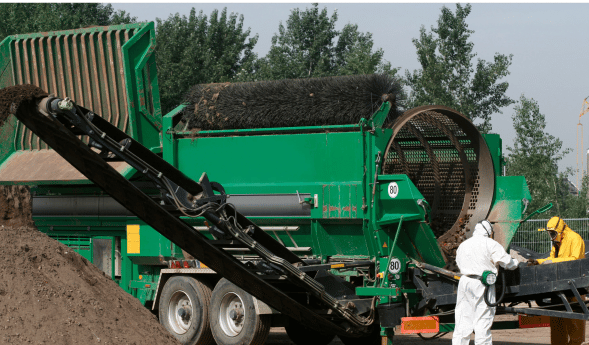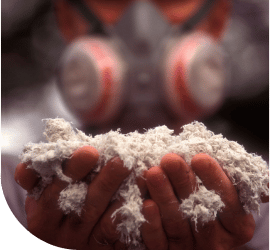Occupational Asbestos Exposure
Employers are required by law to protect their employees from occupational asbestos exposure. If you were exposed to asbestos at work and developed a disease as a result, you may be eligible to file a claim.
Home » National Mesothelioma Law Firm » Asbestos Exposure » Occupational Asbestos Exposure
Occupational asbestos exposure refers to exposure that occurs at work, and it puts people at an increased risk for a number of asbestos-related diseases, including both cancerous and noncancerous conditions. In the past, asbestos was very common across a variety of industries. Today, it’s more highly regulated but is still not completely banned. Employers are required to provide proper protective equipment to their employees and may be liable for compensating employees who develop asbestos-related disease due to occupational asbestos exposure.
What is occupational asbestos exposure?
Occupational asbestos exposure refers to exposure that occurs while an employee is performing work-related activities. Official estimates indicate that about 27 million workers in the United States were exposed to asbestos between 1940 and 1979.
The families of workers may also be at risk for asbestos-related diseases because when workers return home, asbestos fibers may be carried on their clothing, skin or hair. The fibers then enter the air of the home and can be inhaled or swallowed by others who live there. This is known as secondary asbestos exposure.
The Occupational Safety and Health Administration (OSHA) states that there is no “safe” level of exposure to asbestos. In fact, there are reports of mesothelioma caused by asbestos exposures that lasted only a few days. This is more likely to occur when the short-term exposure involves a very high level of asbestos. For example, in certain situations, a significant amount of asbestos is suddenly aerosolized, such as during the collapse of the World Trade Center in 2001. This event created a high-level, short-term exposure for victims and first responders.
Any amount of asbestos exposure has the potential to cause asbestos-related diseases like mesothelioma or lung cancer, but the risk increases with higher levels of exposure. The greater a person’s total cumulative asbestos exposure, the greater their risk of asbestos-related disease. A short exposure to a relatively low level of asbestos is very unlikely to cause disease. However, being exposed to a high level of asbestos for a short period of time or to a lower level over a long period of time increases the risk. For example, people exposed to asbestos at work for 15 years or longer have nearly two and a half times the risk of developing lung disease as those who were exposed for less than five years.
High-Risk Asbestos Exposure Occupations
Certain jobs put people at a higher risk for occupational exposure to asbestos. These include occupations in which people worked in manufacturing, installing or removing asbestos-containing products, or on maintenance of asbestos-containing materials. First responders, such as firefighters, are also at risk, as they can be exposed to asbestos released from damaged material in a burning building.
According to the CDC, workers in the following occupations are at a high risk for occupational asbestos exposure:

Demolition workers

Drywallers

Electricians

Floor covering workers

Furnace workers

Laborers

Libby vermiculite exfoliation plant workers

Longshoremen

Merchant marines
People who were employed in these industries prior to the 1980s, when asbestos began to be regulated, are at the highest risk. However, some workers may still be at risk for asbestos exposure even today. According to a report by the American Thoracic Society, an estimated 1.3 million construction workers in the United States are still at significant risk for occupational asbestos exposure.

Are people still at risk of asbestos exposure?
In the past, asbestos was very widely used across many different industries. Asbestos-related disease was recognized as early as 1918, but asbestos use continued for many more decades. Companies fought the idea of regulation because it would decrease their profits. It was not until the 1970s that the use of asbestos in the United States began to be regulated by the Environmental Protection Agency (EPA).
Although the use of asbestos is now heavily regulated, it still isn’t completely banned. In fact, asbestos imports into the United States continue, and it’s still used to make certain products. In mid-2022, the EPA issued new regulations that will ban the use of asbestos in many products that are still using it, including certain automotive parts and gaskets and diaphragms used for industrial purposes.
In addition to the new products that are still being manufactured using asbestos, there is also a risk caused by materials that were created before the regulations were put into place. For example, workers who perform maintenance on older buildings may be exposed to asbestos as they cut or drill into, or otherwise manipulate, asbestos-containing materials. In 2019, the EPA issued regulations that prevent old asbestos-containing products that have been removed from the market from again being produced and sold, but this regulation still doesn’t completely prevent workers and the public from being exposed to older asbestos-containing products.
Handle Your Mesothelioma Case?

Employee Protection Regulations in the Workplace
OSHA has created regulations to help protect people from being exposed to asbestos while on the job. Some of the regulations include:
- There is a limit set on how much asbestos can be present in the air, known as the permissible exposure limit (PEL). Workplaces must take all reasonable measures to keep asbestos levels below this limit and must monitor the levels of asbestos in all work areas.
- Any area that has a level of asbestos that’s above the limit must be labeled with warning signs.
- If workers will be in an area with an amount of asbestos that’s above the limit, then they must be provided with protective respiratory equipment.
- The employer must provide a separate decontamination area and a lunch area where workers can safely remove their protective equipment to eat.
- Workers must receive training in how to work with asbestos as safely as possible and how to use their protective equipment.
- In certain industries, employers must provide medical surveillance to workers who are at risk for having been exposed to higher levels of asbestos.
Employers are responsible for stringently following these regulations to ensure the safety of their workers. Unfortunately, employers may “cut corners” on safety to save money. This means sacrificing the safety of their workers in favor of increasing their profits. If a worker develops an asbestos-related disease due to occupational asbestos exposure, their employer may be held liable for compensation.
Largely because of the regulations on the use of asbestos, rates of mesothelioma in men have declined in recent years. Men were far more likely than women to have been employed in the occupations at highest risk for asbestos exposure, and these declines are evidence that occupational asbestos exposure is becoming less common.
What are the health hazards of occupational asbestos exposure?
There are several known health risks that are associated with asbestos exposure. The diseases that asbestos can cause include:

Mesothelioma
This is a rare type of cancer that arises in the membranes that surround certain organs. The majority of cases of mesothelioma are associated with significant asbestos exposure.

Lung cancer
Exposure to asbestos significantly increases the risk of lung cancer. There are many different risk factors for lung cancer, including smoking. However, asbestos exposure causes a ten-fold increase in the risk of lung cancer in nonsmokers. Those who are exposed to asbestos and who also smoke have 50 times the baseline lung cancer risk.

Asbestosis
This is a noncancerous disease in which scar tissue forms throughout the lung, which causes it to become stiff. This makes breathing difficult. The levels of asbestos exposure that can cause asbestosis are higher than those that can cause mesothelioma and lung cancer.
All three of these diseases can be fatal. Although treatments are available for both mesothelioma and lung cancer, they often extend life by only a few months. There is currently no medical treatment that can stop the progression of asbestosis.
Asbestos causes these diseases because it’s such a stable mineral. Tiny fibers of asbestos embed themselves into lung tissue. From there, they can work their way into the pleura, which is the mesothelial membrane surrounding the lung. The presence of asbestos in the tissues provokes an inflammatory response by the body. However, because asbestos is so chemically stable, the body is unable to break it down and remove it. The inflammatory response, therefore, continues to occur.
Over time, the sustained inflammation leads to the formation of scar tissue throughout the lung. This is what causes asbestosis. Chemicals released by the inflammatory process can also damage the surrounding tissues, causing changes to their DNA that ultimately lead to cancer.
There are two main types of asbestos: amphibole and serpentine. Amphibole asbestos fibers are straight and sharp, and they become embedded into tissues very easily. Serpentine fibers are curly and may not enter into tissues as readily. Amphibole asbestos is considered to be more dangerous and is more likely to cause diseases like mesothelioma. However, serpentine asbestos (also known as chrysotile) actually causes the majority of cases of mesothelioma simply because it’s far more common, accounting for 90 to 95 percent of the asbestos used in the United States.
By submitting this form, you agree to our terms & conditions. Please read the full disclaimer




























